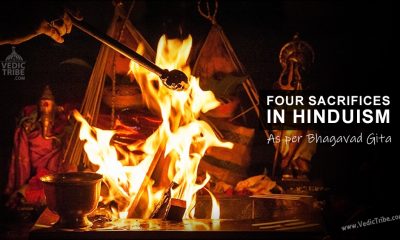History
Hindu Kush and Hindu Genocide
Published
4 years agoon
By
Vedic Tribe
The Hindu Kush is a mountain system nearly 1000 miles long and 200 miles wide, running northeast to southwest, and dividing the Amu Darya River Valley and Indus River Valley. It stretches from the Pamir Plateau near Gilgit, to Iran. The Hindu Kush ranges mainly run thru Afganistan and Pakistan. It has over two dozen summits of more than 23,000 ft in height. Below the snowy peaks the mountains of Hindu Kush appear bare, stony and poor in vegetation. Historically, the passes across the Hindu Kush have been of great military significance, providing access to the northern plains of India.
The Khyber Pass constitutes an important strategic gateway and offers a comparatively easy route to the plains of Punjab. Most foreign invaders, starting from Alexander the Great in 327 BC, to Timur Lane in 1398 AD, and from Mahmud of Ghazni, in 1001 AD, to Nader Shah in 1739 AD attacked Hindustan via the Khyber Pass and other passes in the Hindu Kush (1,2,3). The Greek chroniclers of Alexander the Great called Hindu Kush as Parapamisos or Paropanisos (4). The Hindu name of the Hindu Kush mountains was ‘Paariyaatra Parvat'(5).
EARLY HISTORY OF HINDU KUSH REGION (UP TO 1000 AD)
History of Hindu Kush and Punjab shows that two major kingdoms of Gandhaar & Vaahic Pradesh (Balkh of Bactria) had their borders extending far beyond the Hindu Kush. Legend has it that the kingdom of Gandhaar was established by Taksha, grandson of Bharat of Ayodhya (6). Gandhaar’s borders extended from Takshashila to Tashkent (corruption of ‘Taksha Khand’) in the present day Uzbekistan. In the later period, Mahabharat relates Gaandhaari as a princess of Gandhaar and her brother, Shakuni as a prince and later as Gandhaar’s ruler.
In the well documented history, Emperor Chandragupt Maurya took charge of Vaahic Pradesh around 325 BC and then took over Magadh. Emperor Ashok’s stone tablets with inscriptions in Greek and Aramaic are still found at Qandahar (corruption of Gandhaar?) and Laghman in eastern Afganistan(3). One such stone tablet, is shown in the PBS TV series ‘Legacy with Mark Woods’ in episode 3 titled ‘India: The Spiritual Empire’. After the fall of Mauryan empire, Gandhaar was ruled by Greeks. However some of these Greek rulers had converted to Buddhism, such as Menander, known to Indian historians as Milinda, while some other Greeks became followers of Vishnav sects (Hinduism)(7). Recent excavations in Bactria have revealed a golden hoard which has among other things a figurine of a Greek goddess with a Hindu mark on its forehead (Bindi) showing the confluence of Hindu-Greek art (8). Later Shaka and KushaaN ruled Gandhaar and Vaahic Pradesh. KushaaN emperor Kanishka’s empire stretched from Mathura to the Aral Sea (beyond the present day Uzbekistan, Tajikistan, and Krygzystan)(9).
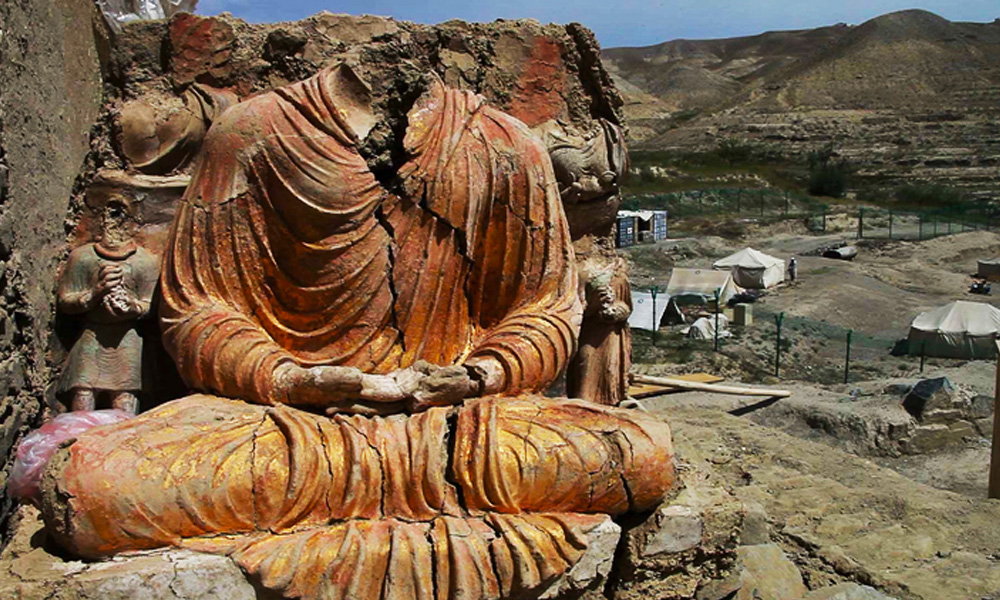
Kanishaka was a Buddhist and under KushaaN influence Buddhism flourished in Gandhaar. Two giant sandstone Buddhas carved into the cliffs of Bamian (west of Kabul) date from the Kushan period. The larger Buddha (although defaced in later centuries by Moslem invaders) is about 175 ft tall (10,11). The Kushan empire declined by 450 AD. The Chinese traveller Hsuan-Tsang (Xuan-zang) travelled thru the region in 7 th century AD and visited many Buddhist religious centers (3) including Hadda, Ghazni, Qonduz, Bamian (3,10,11), Shotorak and Bagram. From the 5 th thru 9 th cenury AD Persian Sasanians and Hepthalites ruled Gandhaar.
During their rule Gandhaar region was again influenced by Hinduism. The Hindu kings (Shahiya) were concentrated in the Kabul and Ghazni areas. The last Hindu Shahiya king of Kabul, Bhimapal was killed in 1026 AD. The heroic efforts of the Hindu Shahiya Kings to defend the northwestern gates of India against the invaders are described by even al-Biruni, the court historian of Mahmud of Ghazni (12). Some excavated sites of the period include a major Hindu Shahiya temple north of Kabul and a chapel that contains both Buddhist and Hindu images, indicating that there was a mingling of two religions (3).
Islamic invasions on Afganistan started in 642 AD, but over the next several centuries their effect was marginal and lasted only a short time after each raid. Cities surrendered only to rise in revolt and the hastily converted returned to their old religion (Hinduism or Buddhism) once the Moslem armies had passed (3).
THUS TILL THE YEAR 1000 AD AFGANISTAN WAS A FULL PART OF HINDU CRADLE.
HINDU KUSH AND THE HINDU GENOCIDE
Now Afganistan is a Moslem country. Logically, this means either one or more of the following must have happened:
a) original residents of Hindu Kush converted to Islam, or
b) they were slaughtered and the conquerors took over, or
c) they were driven out.
Encyclopedia Britannica (3) already informs us above about the resistance to conversion and frequent revolt against to the Moslem conqueror’s rule from 8 th thru 11 th Century AD. The name ‘Hindu Kush’ itself tells us about the fate of the original residents of Gandhaar and Vaahic Pradesh during the later period of Moslem conquests, because HINDU KUSH in Persian MEANS HINDU SLAUGHTER (13) (as per Koenraad Elst in his book ‘Ayodhya and After’). Let us look into what other standard references say about Hindu Kush.
Persian-English dictionary (14) indicates that the word ‘Kush’ is derived from the verb Kushtar – to slaughter or carnage. Kush is probably also related to the verb Koshtan meaning to kill. In Urdu, the word Khud-kushi means act of killing oneself (khud – self, Kushi- act of killing). Encyclopedia Americana comments on the Hindu Kush as follows: The name Hindu Kush means literally ‘Kills the Hindu’, a reminder of the days when (Hindu) SLAVES from Indian subcontinent died in harsh Afgan mountains while being transported to Moslem courts of Central Asia (15). The National Geographic Article ‘West of Khyber Pass’ informs that ‘Generations of raiders brought captive Hindus past these peaks of perpetual snow.
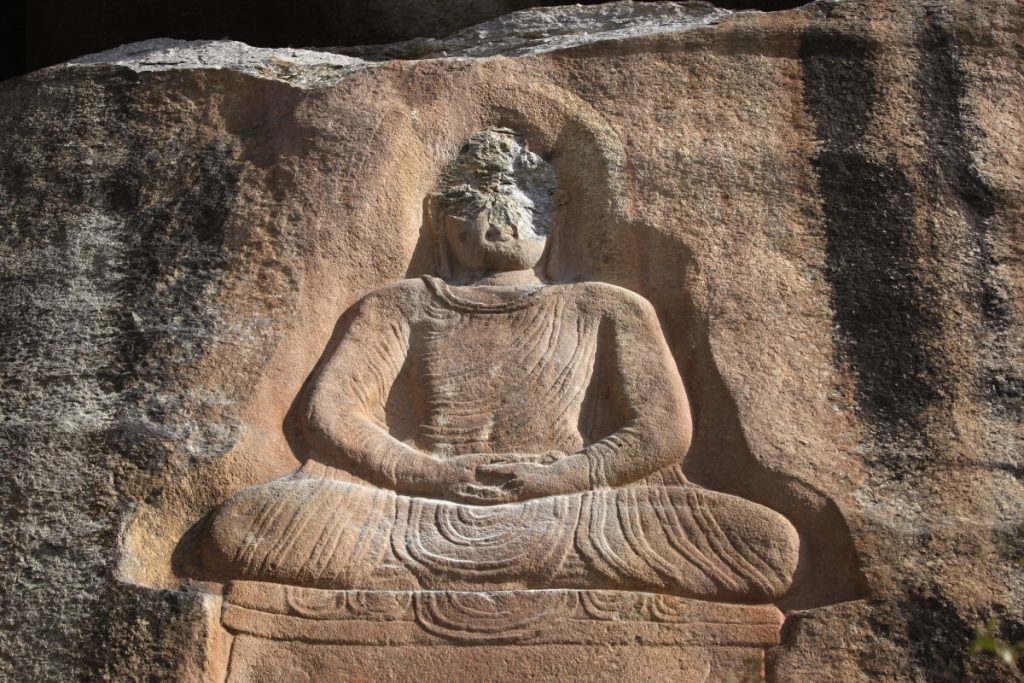
Such bitter journeys gave the range its name Hindu Kush – “Killer of Hindus”‘(10). The World Book Encyclopedia informs that the name Kush, .. means Death ..(16). While Encyclopedia Britannica says ‘The name Hindu Kush first appears in 1333 AD in the writings of Ibn Battutah, the medieval Berber traveller, who said the name meant ‘Hindu Killer’, a meaning still given by Afgan mountain dwellers who are traditional enemies of Indian plainsmen (i.e. Hindus)(2). However, later the Encyclopedia Britannica gives a negationist twist by adding that ‘more likely the name is a corruption of Hindu-Koh meaning Hindu mountains’. This is unlikely, since the term Koh is used in its proper, uncorrupted form for the western portion of Hindu Kush, viz. Koh-i-Baba, for the region Swat Kohistan, and in the names of the three peaks of this range, viz. Koh-i-Langer, Koh-i-Bandakor, and Koh-i-Mondi. Thus to say that corruption of term Koh to Kush occurred only in case of Hindu Kush is merely an effort to fit in a deviant observation to a theory already proposed. In science, a theory is rejected if it does not agree with the observations, and not the other way around. Hence the latter negationist statement in the Encyclopedia Britannica must be rejected.
IT IS SIGNIFICANT THAT ONE OF THE FEW PLACE NAMES ON EARTH THAT REMINDS US NOT OF THE VICTORY OF THE WINNERS BUT RATHER THE SLAUGHTER OF THE LOSERS, CONCERNS A GENOCIDE OF HINDUS BY THE MOSLEMS (13).
Unlike the Jewish holocaust, the exact toll of the Hindu genocide suggested by the name Hindu Kush is not available. However the number is easily likely to be in millions. Few known historical figures can be used to justify this estimate. Encyclopedia Britannica informs that in December 1398 AD, Timur Lane ordered the execution of at least 50,000 captives before the battle for Delhi, .. and after the battle those inhabitants (of Delhi) not killed were removed (as slaves) (17), while other reference says that the number of captives butchered by Timur Lane’s army was about 100,000 (18).
Later on Encyclopedia Britannica mentions that the (secular?) Mughal emperor Akbar ‘ordered the massacre of about 30,000 (captured) Rajput Hindus on February 24, 1568 AD, after the battle for Chitod’ (19). Another reference indicates that this massacre of 30,000 Hindu peasants at Chitod is recorded by Abul Fazl, Akbar’s court historian himself (20). These two ‘one day’ massacres are sufficient to provide a reference point for estimating the scale of Hindu genocide. The Afgan historian Khondamir records that during one of the many repeated invasions on the city of Herat in western Afganistan, 1,500,000 residents perished (11).

Since some of the Moslem conquerors took Indian plainsmen as slaves, a question comes : whatever happened to this slave population? The startling answer comes from New York Times (May-June 1993 issues). The Gypsies are wandering peoples in Europe. They have been persecuted in almost every country. Nazis killed 300,000 gypsies in the gas chambers. These Gypsies have been wandering around Central Asia and Europe since around the 12 th Century AD. Until now their country of origin could not be identified. Also their Language has had very little in common with the other European languages. Recent studies however show that their language is similar to Punjabi and to a lesser degree to Sanskrit. Thus the Gypsies most likely originated from the greater Punjab. The time frame of Gypsy wanderings also coincides early Islamic conquests hence most likely their ancestors were driven out of their homes in Punjab and taken as slaves over the Hindu Kush.
The theory of Gypsie origins in India was first proposed over two centuries ago. It is only recently theta linguistic and other proofs have been verified. Even the Gypsie leadership now accepts India as the country of their origin.
Thus it is evident that the mountain range was named as Hindu Kush as a reminder to the future Hindu generations of the slaughter and slavery of Hindus during the Moslem conquests.
DELIBERATE IGNORANCE ABOUT HINDU KUSH
If the name Hindu Kush relates such a horrible genocide of Hindus, why are Hindus ignorant about it? and why the Government of India does not teach them about Hindu Kush? The history and geography curriculums in Indian Schools barely even mention Hindu Kush. The horrors of the Jewish holocaust are taught not only in schools in Israel and USA, but also in Germany. Because both Germany and Israel consider the Jewish holocaust a ‘dark chapter’ in the history. The Indian Government instead of giving details of this ‘dark chapter’ in Indian history is busy in whitewash of Moslem atrocities and the Hindu holocaust. In 1982, the National Council of Educational Research and Training issued a directive for the rewriting of school texts. Among other things it stipulated that: ‘Characterization of the medieval period as a time of conflict between Hindus and Moslems is forbidden’. Thus denial of history or Negationism has become India’s official ‘educational’ policy (21).
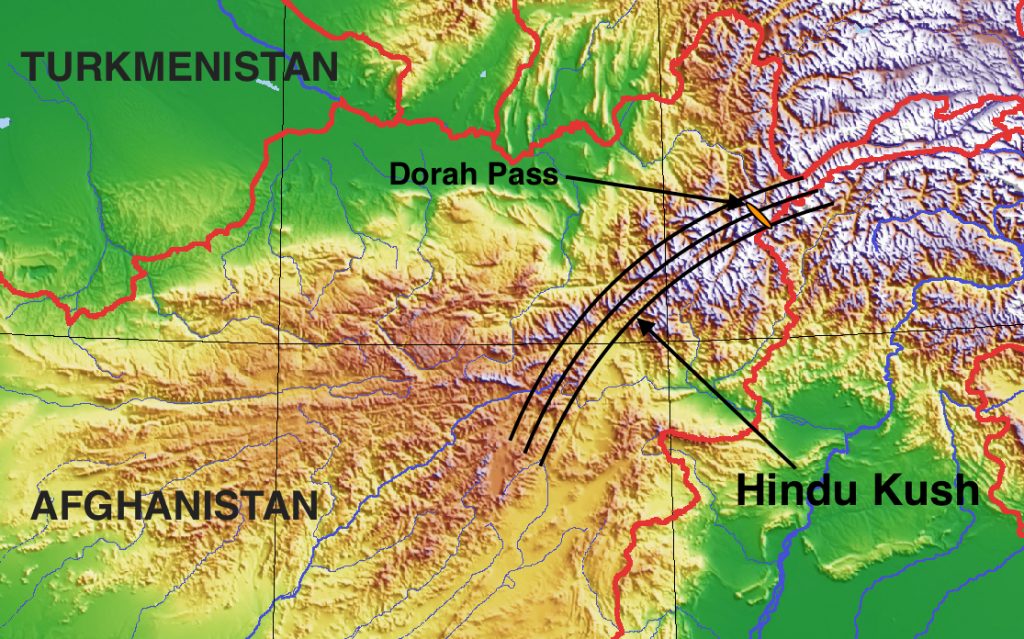
Often the official governmental historians brush aside questions such as those that Hindu Kush raises. They argue that the British version is the product of their ‘divide and rule’ policy’ hence their version is not necessarily true. However it must be remembered that the earliest reference of the name Hindu Kush and its literal meaning ‘Hindu Killer’ comes from Ibn Battutah in 1333 AD, and at that time British were nowhere on the Indian scene. Secondly, if the name indeed was a misnomer then the Afgans should have protested against such a barbaric name and the last 660 plus years should have been adequate for a change of name to a more ‘civil’ name. There has been no effort for such a change of name by the Afgans. On the contrary, when the Islamic fundamentalist regime of the Mujahadeens came to power in 1992, tens of thousands of Hindus and Sikhs from Kabul, became refugees, and had to pay steep ransom to enter into Pakistan without a visa.
In the last 46 years the Indian Government also has not even once demanded that the Afgan Government change such an insulting and barbaric name. But in July 1993, the Government of India asked the visiting Jerusalem Symphony Orchestra to change its name because the word Jerusalem in its name is offensive to Moslem Fundamentalists.
CONCLUSION
It is evident that Hindus from ancient India’s (Hindustan’s) border states such as Gandhaar and Vaahic Pradesh were massacred or taken as slaves by the Moslem invaders who named the region as Hindu Kush (or Hindu Slaughter,or Hindu Killer) to teach a lesson to the future Hindu generations of India. Unfortunately Hindus are not aware of this tragic history. The Indian government does not want the true history of Hindu Moslem conflicts during the medieval ages to be taught in schools. This policy of negationism is the cause behind the ignorance of Hindus about the Hindu Kush and the Hindu genocide. ~ By Shrinandan Vyas
Although in this article Hindu Kush has been referred to as Hindu slaughter, it is quite possible that it was really a Hindu and Buddhist slaughter. Since prior to Moslem invasions influence of Buddhism in Gandhaar and Vaahic Pradesh was considerable. Also as the huge 175 ft stone Buddhas of Bamian show, Buddhists were idol worshipers par excellence. Hence for Moslem invaders the Buddhists idol worshipers were equally deserving of punishment. It is also likely that Buddhism was considered an integral part of the Hindu pantheon and hence was not identified separately.
This article barely scratches the surface of the Hindu genocide, the true depth of which is as yet unknown. Readers are encouraged to find out the truth for themselves . Only when many readers search for the truth, the real magnitude of the Hindu genocide will be discovered.
REFERENCES
- Encyclopedia Britannica, 15 th Ed, Vol.5, p.935, 1987
- Encyclopedia Britannica, 15 th Ed, Vol.14, pp.238-240, 1987
- Encyclopedia Britannica, 15 th Ed, Vol.13, pp.35-36, 1987
- The Invasion of India by Alexander the Great (as described by Arrian, Q.Curtius, Diodoros, Plutarch & Justin), By J.W.McCrindle, Methuen & Co., London, p.38, 1969
- Six Glorious Epochs of Indian History, by Veer Savarkar, Savarkar Prakashan, Bombay, 2nd Ed, p.206, 1985
- Chanakya – a TV series by Doordarshan, India
- Encyclopedia Britannica, 15 th Ed, Vol.21, pp.36-41, 1987
- V.Sarianidi, National Geographic Magazine, Vol.177, No.3, p.57, March 1990
- Hammond Historical Atlas of the World, pp. H4 & H10, 1993
- W.O.Douglas, National Geographic Magazine, vol.114, No.1, pp.13-23, July 1958
- T.J.Abercrombie, National Geographic Magazine, Vol.134, No.3, pp.318-325, Sept.1968
- An Advanced History of India, by R.C.Majumdar,
H.C.Raychaudhuri, K.Datta, 2nd Ed., MacMillan and Co, London, pp.182-83, 1965 - Ayodhya and After, By Koenraad Elst, Voice of India Publication, p.278, 1991
- A Practical Dictionary of the Persian Language, by J.A.Boyle, Luzac & Co., p.129, 1949
- Encyclopedia Americana, Vol.14, p.206, 1993
- The World Book Encyclopedia, Vol.19, p.237, 1990
- Encyclopedia Britannica, 15 th Ed, Vol.21, pp. 54-55, 1987
- An Advanced History of India, by R.C.Majumdar, H.C.Raychaudhuri, K.Datta, 2nd Ed., MacMillan and Co, London, pp.336-37, 1965
- Encyclopedia Britannica, 15 th Ed, Vol.21, p.65, 1987
- The Cambridge History of India, Vol.IV – The Mughul Period, by W.Haig & R.Burn, S.Chand & Co., New Delhi, pp. 98-99, 1963
- Negationism in India, by Koenraad Elst, Voice of India Publ, 2nd Ed, pp.57-58, 1993
You may like
History
Snakes and Ladders, Originated in Ancient India called Mokshapat or Moksha Patamu
Published
3 years agoon
January 21, 2021By
Vedic Tribe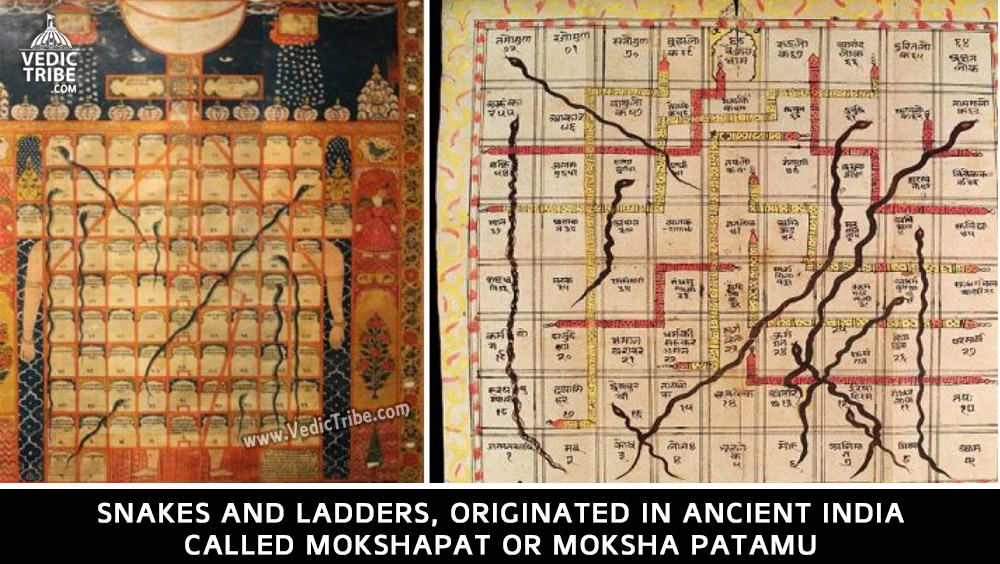
The board game, today called Snakes and Ladders, originated in ancient India, where it was known with the name Mokshapat or Moksha Patamu.
It’s not exactly known when or who invented it, though it’s believed the game was played at a time as early as 2nd century BC. According to some historians, the game was invented by Saint Gyandev.
Originally, the game was used as a part of moral instruction to children. The squares in which ladders start were each supposed to stand for a virtue, and those housing the head of a snake were supposed to stand for an evil. The snakes outnumbered the ladders in the original Hindu game. The game was transported to England by the colonial rulers in the latter part of the 19th century, with some modifications.
Through its several modifications over the decades, however, the meaning of the game has remained the same — ‘that good deeds will take people to heaven (Moksha) while evil deeds will lead to a cycle of rebirths in lower form of life (Patamu).
The modified game was named Snakes and Ladders and stripped of its moral and religious aspects and the number of ladders and snakes were equalized. In 1943, the game was introduced in the US under the name Chutes and Ladders.
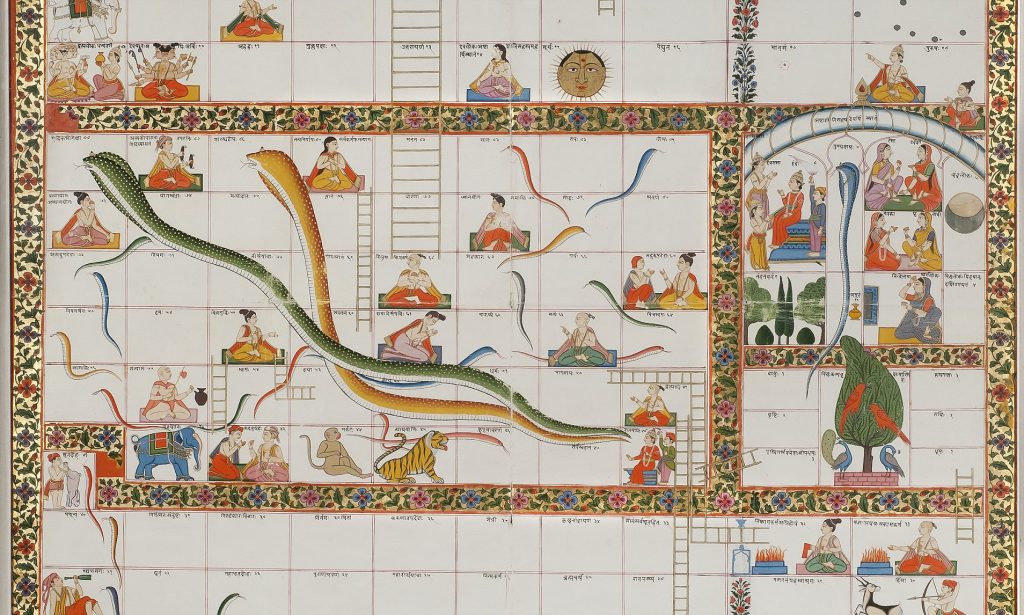
The Game of Knowledge
Originally, the game of Snakes and Ladders was known variously as Gyan Chaupar (meaning ‘Game of Knowledge), Mokshapat, and Moksha Patamu, and was originally a Hindu game. Nobody knows for sure as to who invented this game, or when it was created.
It may be said that whilst the gameplay of Gyan Chaupar is the same as today’s Snakes and Ladders, the board and higher objective of the game may be said to be quite different. Like the modern Snakes and Ladders board, the number of squares in that of Gyan Chaupar may vary. One version of this board, for instance, contains 72 squares, whilst another has 100. A major difference between the traditional and modern versions is the fact that in the former, a virtue or a vice and the effects of these virtues and vices, or something neutral is placed within each box.
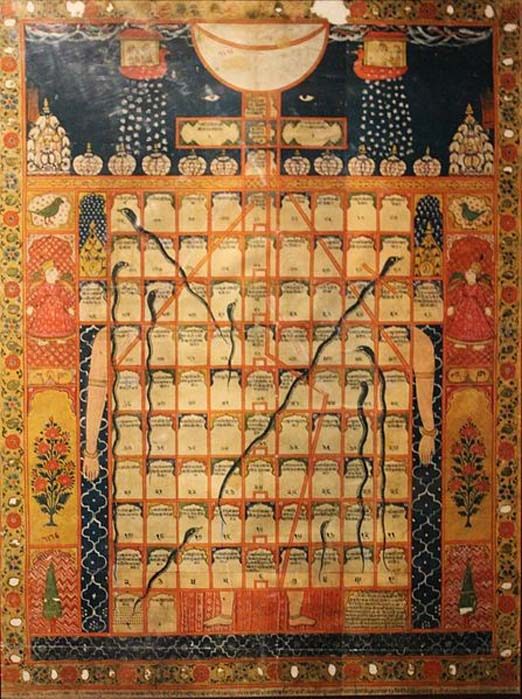
For instance, in an Indian Gyan Chaupar board of 72 boxes, squares number 24, 44, and 55 have the vices of bad company, false knowledge, and ego respectively. As the game places great emphasis on karma, the Hindu principle of cause and effect, each vice (the snakes’ heads) has a corresponding effect. Thus, for the vices mentioned above, the corresponding effects are conceit or vanity, plane of sensuality, and illusion. On the other hand, the virtues of purification, true faith, and conscience are contained in squares number 10, 28, and 46, and these lead to heavenly plane, plane of truth, and happiness respectively. In this version of the board, the goal is to reach box number 68, which is the plane of Shiva.
Religious Teaching Tool
This game was so popular that it was also adopted and adapted by other religions that existed in the Indian subcontinent. It is known that Jain, Buddhist, and Muslim adaptations of the game exist, as the concepts of cause and effect, and reward and punishment, are common to them. For devout followers of these religions, the game may be played as a form of meditation, as a communal exercise, and even as part of one’s religious studies without the use of more conventional books or sermons.
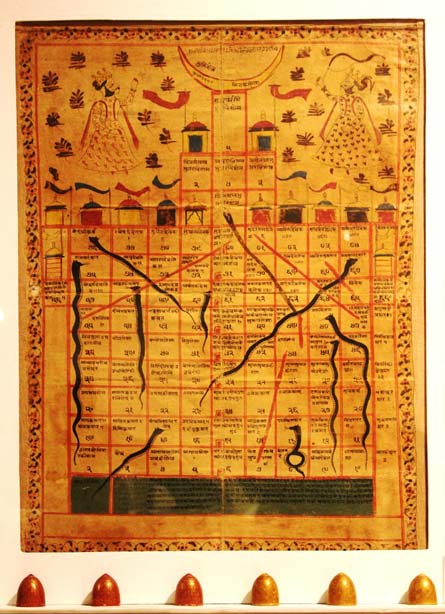
It may be added that many of the surviving game boards are works of art in their own right, as they contain elaborate illustrations of human figures, architecture, flora and fauna, etc. These boards were commonly made of painted cloth, and most of the extant ones date from after the middle of the18th century AD.
The Modern Game
The game of Gyan Chaupar became Snakes and Ladders towards the end of the 19 th century, when it was introduced to Great Britain by India’s colonial rulers. Whilst the original gameplay was maintained, its underlying philosophical message was greatly diminished. The religious virtues and vices were replaced by two-part cartoon dramas connected either by a snake or a ladder. Additionally, the number of snakes and ladders were equalized, whilst in the original ones, there were usually more snakes than ladders, which symbolizes the belief that it is far easier to fall prey to vice than to uphold virtue. From Great Britain, the game traveled to the United States, where it was introduced in 1943 by Milton Bradley as Chutes and Ladders.
Bharat
Telhara University – Older than Nalanda, Vikramshila Universities
Published
3 years agoon
December 29, 2020By
Vedic Tribe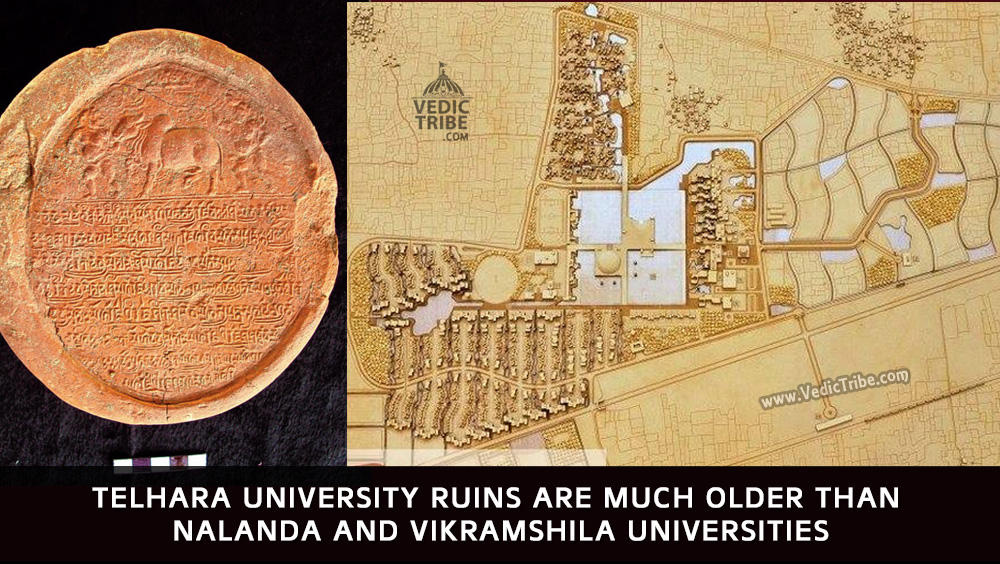
It was a useful mound, no doubt. A good vantage point where villagers occasionally relieved themselves.
But who would have thought that deep beneath its golden brown earth would be stories of dynasties and empires that now suggest that this — Telhara, a village 33 km from the ruins of the more famous Nalanda University — could be ‘Tilas-akiya’ or ‘Tiladhak’, the place Chinese traveler Hiuen Tsang visited and wrote about during his travels through India in 7th century AD? So far, there were only vague references but recent excavations at the mound suggest that Telhara was indeed an ancient university or seat of learning with seven monasteries.
The Bihar government has been calling the Telhara project one of its biggest after the excavations that unearthed Nalanda and Vikramshila universities. The excavation at Telhara should have happened earlier, say experts, but the site lost out to the more famous Nalanda.
The Telhara project that started on December 26, 2009, has so far come across over 1,000 priceless finds from 30-odd trenches — seals and sealing, red sandstone, black stone or blue basalt statues of Buddha and several Hindu deities, miniature bronze and terracotta stupas and statues and figurines that go back to the Gupta (320-550 AD) and Pala (750-1174 AD) empires. But the 2.6-acre mound has now thrown up the most tantalising find yet — evidence of a three-storied structure, prayer hall and a platform to seat over 1,000 monks or students of Mahayana Buddhism.
The terracotta monastery seals — a chakra flanked by two deers — unearthed at Telhara are similar to those at Nalanda, suggesting Telhara or Tiladhak was another great seat of learning besides Nalanda and Odantpuri during the Gupta and Pala reigns. It was the discovery of a similar monastery seal that clinched it for Nalanda University.
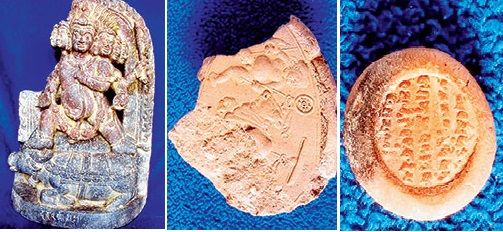
Former Archaeological Survey of India director B S Verma, who between 1971 and ’81 supervised the excavation at the site of the ancient Vikramshila university, says, “Telhara or Tiladhak has much more convincing epigraphical proofs — monastery inscriptions — than Vikramshila. The findings that match Hiuen Tsang’s account do more to convince that the place was a university or mahavihara similar to Nalanda.”
In his book, The Antiquarian Remains in Bihar, historian D R Patil writes about Hiuen Tsang’s description of Telhara. “Hiuen Tsang describes Telhara or Tilas-akiya as containing a number of monasteries or viharas, about seven in number, accommodating about 1,000 monks studying in Mahayan. These buildings, he says, had courtyards, three-storied pavilions, towers, gates and were crowned by cupolas with hanging bells. The doors and windows, pillars and beams have bas relieves (sculptures in guilded copper). In the middle vihara is a statue of Tara Bodhisatva and to the right (is) one of Avlokiteshwar”.
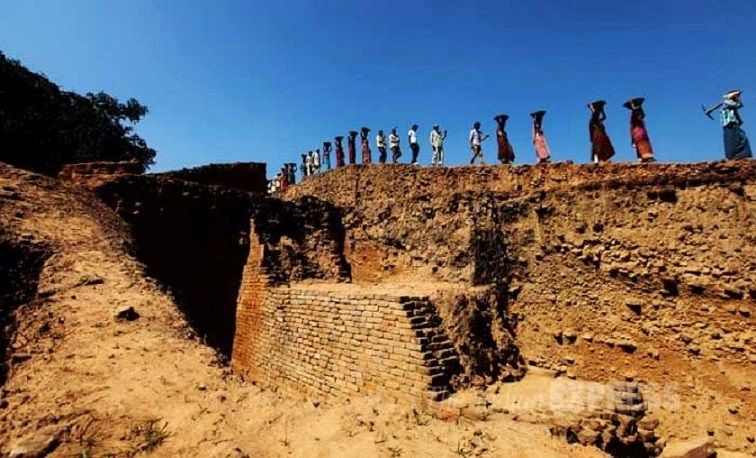
Other history books too talk of Tiladhak monastery, on the western side of Nalanda, as having four big halls and three staircases. It is said the mahavihara or university was built by one of the descendants of Magadha ruler Bimbisara. The monastery was decorated with copper and also had small copper bells that gently chimed in the breeze.
For months now, the excavation has been unearthing these stories. Apart from the mound that is now being dug up, Telhara has six other mounds — five of which have settlements and one which is partially elevated.
Atul Kumar Verma, director (archaeology) of the Bihar government’s Department of Art and Culture, says, “Since the excavations suggest that Telhara might have been a contemporary of Nalanda, it is quite possible that it was either an independent university for specialized education or that students graduating from Nalanda University would come here for specialized study. It is a great feeling to see the place emerging as the next big find after Nalanda. It has also aroused great curiosity and attracted even the likes of Nobel laureate Amartya Sen.” Sen wrote in the visitors’ book: “What a wonderful site, really thrilling! And so skillfully excavated and restored.”
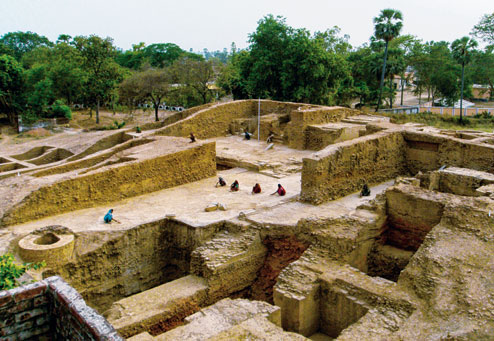
“We have found the courtyard that might have been an extension of the platform Hiuen Tsang had described,” Nand Gopal, camp in-charge at the Telhara site, says, peering into his optical line meter that’s mounted on a tripod.
In more recent times, it was A M Broadley, then magistrate of Nalanda, who in 1872 wrote about “Tilas-akiya” as a university and site of learning. British army officer and archaeologist Sir Alexander Cunningham, who visited the place between 1872 and 1878, wrote about inscriptions describing “Teliyadhak” as a place that had seven monasteries and which matched Hiuen Tsang’s account. A statue of the 12-armed Avlokiteshwar Buddha found from a Tiladhak site is at the Indian Museum in Kolkata. Perhaps the best known Pala sculpture from Telhara is now in Rietberg Muzeum, Zurich.
Though there was this and more proof that Telhara could be sitting on a glorious past, it wasn’t until December 2009 that the excavations finally began. Telhara panchayat head Awadhesh Gupta claims to have been the one who got things started.
“We all knew Telhara was once a great seat of learning, but nobody did anything to prove it. In 1995, I approached the Congress government requesting that the place be excavated but got no assurance. When Bihar Chief Minister Nitish Kumar visited the site in 2007, I put up this demand once again. The villagers were not happy with me. They thought I should have demanded something more concrete than just the digging of a mound.”
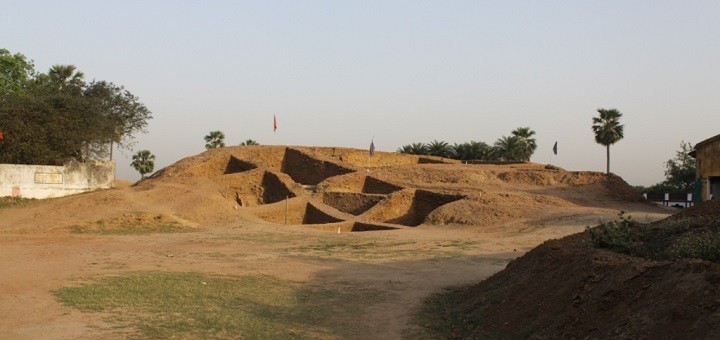
But the mukhiya may have had the last laugh. Villagers now talk about Telhara being part of the Nalanda-Rajgir circuit and how that could bring them jobs and better opportunities. “We hope the site is conserved and clubbed with Nalanda to attract tourists. The site has already given temporary jobs to 70 villagers,” says Anil Kumar, a villager.
It was a useful mound, no doubt.
Experts associated with its excavation are now claiming that the university originated in the Kushan period.
Atul Kumar Verma said that in the recent excavation, archaeologists have found some bricks of very large size (42x36x6.5cm) substantiating that the university belonged to the Kushan period. “Bricks of the Kushan period were quite large from other dynasties, including the Gupta and Pala periods,” said Verma.
While the Kushan period is considered to be 1st century AD, the Gupta dynasty ruled from 3rd to 6th century AD.
MAJOR FINDINGS
SEALS AND SEALING
The recovery of over 100 terracotta seals and sealings from the Gupta and Pala periods provides strong evidence of this being a Buddhist university. Besides seals of the chakra flanked by two deers, other seals have inscription of Buddhist mantras. Seals of Gaj-Lakshmi and flying birds were also found. Some inscriptions that have not yet been deciphered would be sent to Mysore for deciphering.
PLATFORM, TEMPLES
Just above the ashen layer — said to be proof of Turkish general Bakhtiyar Khilji having destroyed the monastery — is the sanctum sanctorum of three Buddhist shrines, each measuring 3.15 square metres. A big platform, found just below this ashen layer, is said to have accommodated over 1,000 monks.
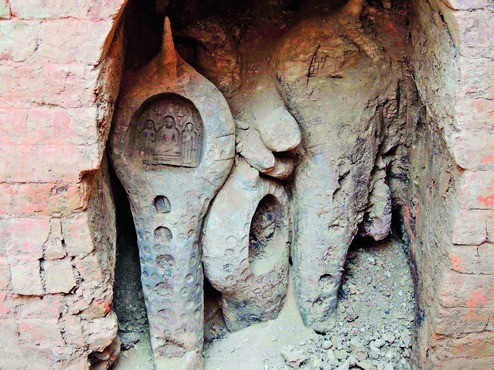
CELLS FOR TEACHERS
The excavation has so far revealed 11 cells of 4 square meters each. It is believed that these were faculty quarters. There is evidence of bricks from the Gupta and Pala periods.
COPPER BELL CHIMES
The excavation revealed several broken pieces of small bells. Parts of molten copper also suggest that the monastery was well-decorated.
CAUTION INSCRIPTION
A stone inscription in Sanskrit (early Nagari script), probably written just before the destruction of the Tiladhak mahavihara, says, “He who tries to destroy this monastery is either a donkey or a bull”. Below the stone inscription are images of the two animals.
FASTING BUDDHA AND VOTIVE STUPA
A miniature terracotta image of a fasting Buddha from the Pala period is a rare find. A six-foot-tall votive stupa from the Pala period suggests the prevalence of Buddhism.
MAURYAN PERIOD
Bone tools and pottery shards of Northern Black Polished Ware points to this being a settlement in the Mauryan period.
STONE SCULPTURES
Among the over 15 stone sculptures found at the site are a red sandstone sculpture of Bodhisatva, Avlokiteshwar, Manjusri and the Buddha in his ‘earth witness’ mudra. A black stone statue of Buddha in abhay mudra (fearless mode) from the Pala period has been found. The red sandstone Bodhisatva sculpture is believed to be from the Gupta period. Some sculptures of Hindu deities such as Uma Maheshwar and Ganesh and Vishnu from the later Pala period were also found. The presence of a Yamantaka sculpture is evidence of Tantric Buddhism at the monastery.
History
India’s first Islamic Mausoleum Was Built on Top of Ancient Hindu Temple
Published
3 years agoon
December 28, 2020By
Vedic Tribe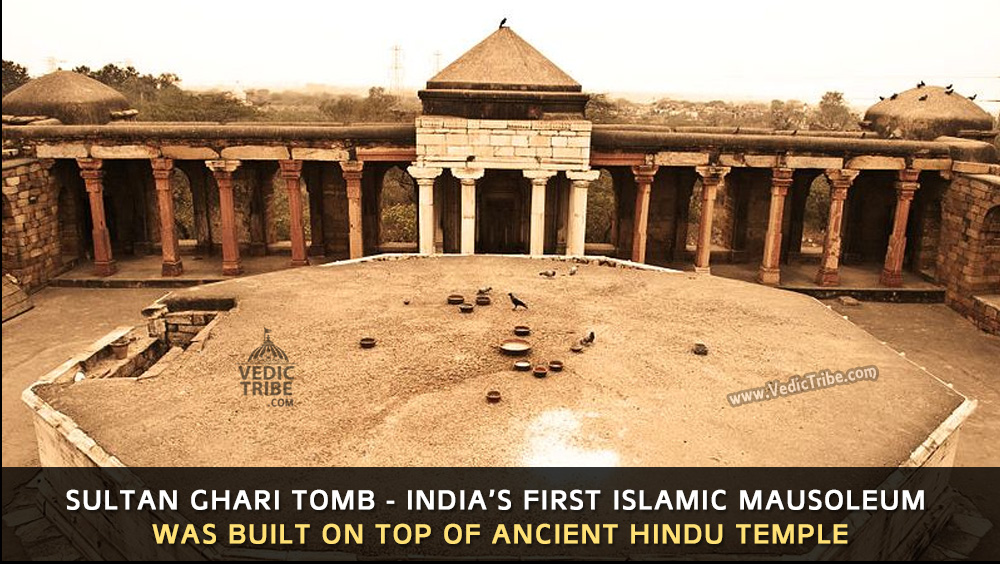
About 6 km west of Qutab Minar in Delhi, there lies a tomb called Sultan Ghari which is believed to be the final resting place of Prince Nasir’ud-Din Mahmud, the uncrowned eldest son of Sultan Shamsuddin Iltutmish of the Slave Dynasty built in 1231 AD. It was the first Islamic Mausoleum built in India.
However, engraved symbols of animals, Shiva Linga and the Sanskrit inscriptions on ceiling tell a different tale altogether. The beams of the octagonal crypt bear figures of Kamadhenu, the celestial cow and Varaha, the wild boar reincarnation of Lord Vishnu. These two animals were a royal Hindu insignia and considering the ideology of Islam against idols and the immense hatred towards pigs, it is very unlikely that such statues would adorn the inside of a Muslim tomb.
![]()
Iltutmish invaded eastern part of India in 1225 AD which resulted in signing of a treaty between him and Iwaz Khalji, the ruler of Eastern India. After a few successive battles, Prince Nasiru’d-Din Mahmud was appointed governor of Lakhnauti province who later merged the province of Oudh with Bengal and Bihar, gaining him the title of “Malik-us-Sharq” (King of the East) by his father.
The Prince was killed in 1229 AD after a very short rule of 18 months. Grieved by the death of his favourite son, Iltutmish commissioned the Sultan Ghari Tomb. After Iltutmish’s death in 1236, his daughter, Razia Sultana ruled the kingdom until her defeat and death in 1240 AD.
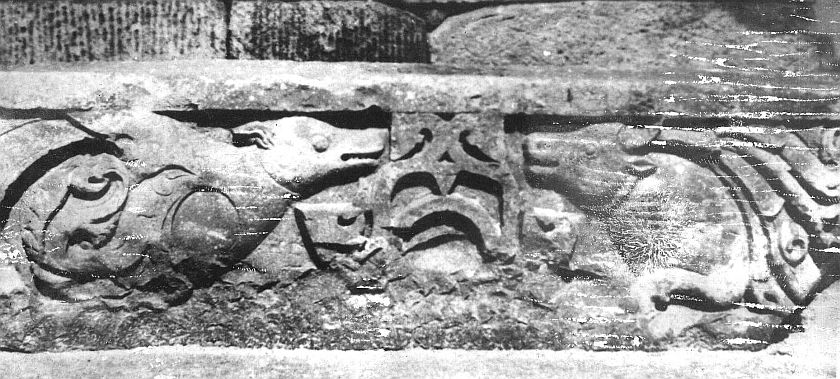
While ASI is pretty much silent on this matter, historians and archaeologists justify these carvings as new buildings being fashioned out of the debris of some Hindu buildings or that the workmen may have been Hindus and would have built the tomb in Hindu style. Their arguments in favor of the tomb fail here because no building worth its name can be build out of old debris and no workman would even dare to fashion a building for which he is hired according to his taste rather than that of the owner’s.
The building is also of an octagonal shape which is another Hindu specialty.
Due to indifference or perhaps purposeful negligence by the government and ASI, we may never know the reality and history of this ancient Hindu temple.

Follow us on Facebook
Follow us on Twitter
Latest


Seven Vows and Steps (pheras) of Hindu Wedding explained
Views: 5,526 Indian marriages are well renowned around the world for all the rituals and events forming part of the...


Sari or Saree is symbol of Indian feminism and culture
Views: 4,724 One of the most sensual attires of a woman in India is undoubtedly the sari. It is a...


Atithi Devo Bhava meaning in Hinduism and India
Views: 4,055 Atithi Devo Bhava, an ancient line taken from the Hindu scriptures and was originally coined to depict a visiting person whose...


Sanskrit Is More Than Just A Method To Communicate
Views: 3,284 -By Ojaswita Krishnaa Chaturvedi anskrit is the language of ancient India, the earliest compilation of sound, syllables and...


Significance of Baisakhi / Vaisakhi
Views: 4,324 Baiskhi is also spelled ‘Vaisakhi’, and is a vibrant Festival considered to be an extremely important festival in...


Navaratri: The Nine Divine Nights of Maa Durga!
Views: 5,254 – Shri Gyan Rajhans Navratri or the nine holy days are auspicious days of the lunar calendar according...


History of Vastu Shastra
Views: 7,422 Vastu Shastra (or short just Vastu) is the Indian science of space and architecture and how we may...


Significance of Bilva Leaf – Why is it dear to Lord shiva?
Views: 6,641 – Arun Gopinath Hindus believe that the knowledge of medicinal plants is older than history itself, that it...


Concept of Time and Creation (‘Brahma Srishti’) in Padma Purana
Views: 7,756 Pulastya Maha Muni affirmed to Bhishma that Brahma was Narayana Himself and that in reality he was Eternal....


Karma Yoga – Yog Through Selfless Actions
Views: 7,403 Karma Yoga is Meditation in Action: “Karma” means action and “yoga” means loving unity of our mind with...
Tags
Trending Now
-

 Bhartiya Culture2 years ago
Bhartiya Culture2 years agoSeven Vows and Steps (pheras) of Hindu Wedding explained
-

 Bhartiya Culture2 years ago
Bhartiya Culture2 years agoSari or Saree is symbol of Indian feminism and culture
-

 Bhartiya Culture2 years ago
Bhartiya Culture2 years agoAtithi Devo Bhava meaning in Hinduism and India
-

 Bhartiya Culture2 years ago
Bhartiya Culture2 years agoSanskrit Is More Than Just A Method To Communicate


